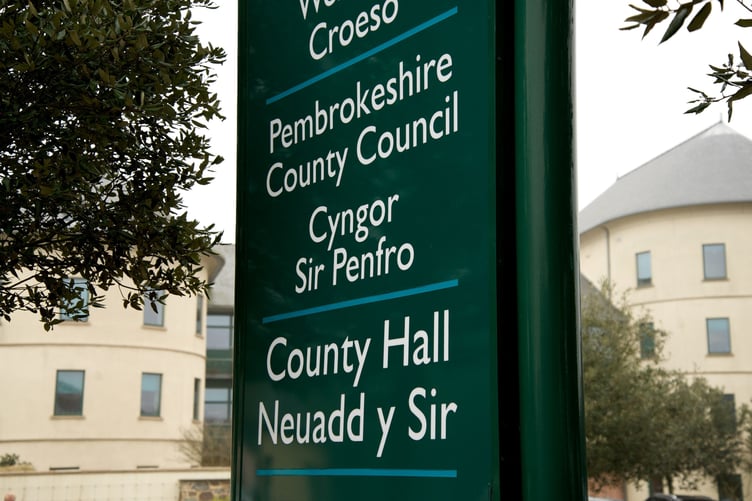Councils across Wales have a collective hole in their finances amounting to £326.7m for the coming financial year, Unison research has found, as Pembrokeshire councillors warn of further ‘bleak times’ ahead.
Pembrokeshire County Council is facing a predicted overspend in its annual budget of nearly £3m, with a moratorium on all non-essential expenditure still in force, senior councillors heard this month.
Members of the Local Authority’s Cabinet, meeting on September 9, heard a report on the quarter one figures for the 2024-25 budget, highlighting an expected overspend of £2.9m by the end of the financial year.
A year ago, that q1 overspend – for the 2023-24 budget – was predicted at £4.8m.
The budget for 2024-25 was approved by council on March 7. This is the first budget monitoring report for 2024-25.
A report for Cabinet members stated: “The approved revenue net expenditure budget for 2024-25 is £303.5m. This budget was set against a backdrop of increased level of demand, complexity and cost of packages within our School ALN provision, Children’s Services, Adult Services and Homelessness.
“This increase in demand, complexity and cost of packages has continued into 2024-25 with material projected overspends in each of these areas totalling £5.3m.
“Although work is being undertaken to try to reduce the cost of packages, it should be noted that these demand levels are projected to continue into 2025-26 and future years, creating further additional permanent budget pressures that will either need to be met through additional budget savings, income generation or increased council tax.”
The projected outturn at quarter one of 2024-25 is £306.4m, representing a projected overspend of £2.9m.
The report before members, presented by Cabinet Member for Corporate Finance and Efficiencies Cllr Joshua Beynon also detailed the medium term financial plan, with longer-term financial pressures for the council.
The report also highlighted the high cost of out-of-county in-care placements for children’s services, with the authority due to open up its first in-county residential home for children later this year, stating: “The majority of the Children’s Services pressures continue to pertain to the high costs of residential placements that we have to arrange in order to safely meet complexity of need and fulfil statutory responsibilities.
“Our Children’s Services commissioning team continue to mitigate this pressure through reviews of existing provision and shaping a market of more locally based provision, which aligns with the Welsh Government’s proposed legislation for the elimination of profit from the provision of children’s care.”
It said adult care and services were also facing pressure: “Complexity of need continues to feature within adult services as can be seen with the increase in demand and complexity of residents requiring nursing and residential care placements.
“From a housing perspective, the number of individuals in temporary accommodation overall has reduced from the previous quarter but the numbers within B&B accommodation remains high.”
Members backed a recommendation to note the report and the moratorium on all non-essential expenditure which is in force, and for the senior leadership team and appropriate Cabinet members to implement in-year savings measures to address the projected overspend for 2024-25.
Members also agreed to note similar measures to “identify potential savings to assist in addressing the indicative budget gap of £31.4 million for 2025-26 and £78.2 million across the period of the Medium-Term Financial Plan”.
Following the meeting, representing the wards of St. Florence and St. Mary Out Liberty (New Hedges), County Councillor Rhys Jordan warned his constituents of potential further ‘bleak’ times ahead - with either a further council tax hike on the cards or significant cuts to more services, to allow the Local Authority to balance the books.

“As we look ahead to the new year, we are once again faced with the daunting task of budget setting,” stated Cllr Jordan.
“The financial outlook for the next year is, frankly, bleak. We are looking at a £30 million-plus deficit, which presents us with some very tough decisions.
“In order to bridge this gap, we will either need to raise council tax again or make significant cuts to services.
“Neither option is ideal, and I know both will have serious implications for our residents. Some of you may have already heard about the reduction of certain services, such as day centres, which are vital to many in our community.
I’ve always been vocal about my belief that, as a relatively small council, we need to focus on delivering our statutory services to a high standard.
“This will inevitably mean rethinking how we deliver non-statutory services and making difficult decisions about which services we can realistically continue to provide.
“I want to reassure you that I will continue to fight for the services we need, while also ensuring that the council provides value for money.
“Balancing the books is never easy, especially when it comes to services that people rely on, but I am committed to making sure we navigate this challenging period with the best interests of our community in mind.
“In the coming months, I will be working closely with colleagues to explore every option available to us as we move into the budget-setting process.
“We will need to think creatively, and in some cases, make sacrifices, but my priority remains ensuring that the most vulnerable in our community are protected, and that statutory services are delivered effectively and efficiently.
“It’s going to be a challenging time for all of us, but I’m confident that by working together, we can find solutions that work for our community,” he added.
Pembrokeshire is not the only council in Wales facing a bleak financial future in the area, with Powys, Carmarthenshire, and Gwynedd all warning of further cuts and council tax rises in the future on top those seen in April.
Meanwhile, Ceredigion County Council’s Chief Executive has warned of an “unfair” “two-tier funding system” between rural and urban areas.
In recent times, Ceredigion Council has been forced to look at closing schools, a care home, and bring in parking charges on Aberystwyth promenade in a bid to ease its financial.
Those plans, though deeply unpopular, are necessary to balance the budget despite an 11.9 per cent council tax rise for residents in April because the funding “just isn’t there” to operate services at the level required.”
Ceredigion County Council Chief Executive Eifion Evans told members during a marathon meeting on the proposed school closures that “the dynamic across Wales is, at the moment, in my opinion – and I’m probably going to get a rap across the knuckles for saying this – a two-tiered funding model and urban-centric areas get far more generous settlement than rural areas.”
Council leader Cllr Bryan Davies told the same meeting that when he is “banging the drum for Ceredigion” in meetings with the Welsh Local Government Association he “gets branded by more urban leaders that I’m being racist against them.”
“That is the narrative,” he said.
The council has already warned that if the Welsh Government doesn’t adequately fund councils in rural Wales, projections for 2025/2026 already mean that further council tax rises and service cuts are on the cards.
The council wants the Welsh Government to recognise the “unique challenges” rural authoirties face when allocating funding.
Funding to Ceredigion County Council from the Welsh Government rose by less than three per cent for 2024/2025, lower than the national average and the lowest increase per head of population across all of Wales, and well below any inflationary pressures on costs.
A report suggests that at least £10m in savings through cuts and tax rises will need to be found in Ceredigion until at least 2027.
In the past 10 years, figures show, Ceredigion County Council has had to find more than £60m in budget savings, as austerity kicked off a “considerable period of real term decreases in funding”.
That figure is likely to rise until a revamped Welsh Government funding formula which improves the outlook for councils in rural Wales – repeatedly called for by Ceredigion council leaders – is introduced.
Carmarthenshire Council is facing “some bleak winter months” too, as it tries to budget for wage rises it has no control over while reining in overspending, a cabinet member said.
Like all local authorities, the council is starting to plan for the 2025-26 financial year while updating its three-year budget outlook.
Given its reliance on central Government for funding, the picture will become clearer when Chancellor Rachel Reeves delivers her first budget on October 30 and the Welsh Government then sets out its spending priorities.
The mood music from UK Labour hasn’t been joyous with much focus on what it claims is a £22 billion black hole in the country’s finances and a need for short-term pain for longer-term gain.
Cllr Alun Lenny, Carmarthenshire’s cabinet member for resources, said the council was currently looking at savings of £11.9 million in 2025-26. He added that there was uncertainty about whether what he said was a 5.5% pay rise this year for teachers would be fully funded by Cardiff Bay.
Cllr Lenny said last year’s teacher pay rises weren’t fully funded in Wales, resulting in a £3 million “hit” for Carmarthenshire. “The Welsh Government must meet the costs of this and other uplifts,” he said at a cabinet meeting.
Cllr Lenny also said funding for pension contributions for teachers and firefighters was still unclear for the current financial year.
The Plaid Cymru councillor said the £11.9 million savings forecast, followed by £22 million of further savings over the next two years, was “yet again a huge ask”.
He said: “We might have to consider very difficult decisions which are likely to go very much against the grain.”
A report before cabinet said council departments were currently forecast to overspend by £17.9 million this financial year – a situation it described as “extremely concerning”. The biggest portion of this projected £17.9 million is schools overspending by £10.8 million collectively.

The council’s budget forecast for 2025-26 assumes a 1% increase in funding from the Welsh Government – taking the figure to £354.1 million – and a 4% council tax hike, bringing in a further £127.9 million. These numbers may well change before full council sets the 2025-26 budget early next year.
Cllr Lenny said: “Once again I’m afraid we face some bleak winter months as we’ll have to cope with a very tight budget timetable, as in recent years, for reasons totally out of our control.”
Plaid council leader Darren Price said it was a concerning time for all local authorities in Wales.
“Discussions with leaders and cabinet members right across the country show there is significant concern, really, about local Government’s ability to fund this (budget) gap,” he said. “And clearly there is a massive piece of work for us to do in the next couple of months in terms of lobbying both the UK and Welsh Governments to ensure that these wage and price rises we all face are funded sufficiently over the next year and the medium term.”
The Welsh Government said funding for local Government rose by 7.9% in 2023-24 and then 3.3% this financial year.
A spokesperson said meeting the cost of teachers’ pay was the responsibility of councils.
“Where necessary, we have made additional funding available in-year to local authorities,” she said.
Asked about a 5.5% pay rise for teachers in the current year, she said: “Budgets for 2024-25 were set in March with an expectation about the level of public sector pay. The award we are currently consulting on for teachers is above this level and the Welsh Government will provide additional funding for this.”
Unison said that it “welcomes the commitments by the new Labour government to introduce multi-year funding settlements to allow local councils to better plan their spending and end wasteful competitive bidding for funding.”
While council funding in Wales is devolved, the Welsh Government should receive additional resources from Westminster that can be passed to their councils as part of those plans.




Comments
This article has no comments yet. Be the first to leave a comment.